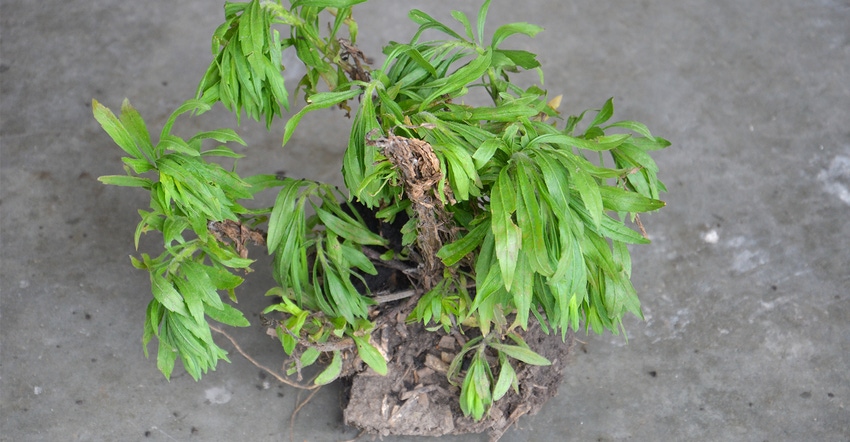
If you ask Jeff Nagel the No. 1 factor for successful control of tough weeds in postemergence situations, you won’t have to wait for his answer.
“Spray small weeds!” says Nagel. “It’s all about weed size. You’re really stepping off the ledge if you think you’re going to control tough weeds more than 4 inches tall.”
Nagel is an agronomist with Ceres Solutions. Based in Lafayette, he works primarily along the western half of the state, trying to provide insights that will lead to better weed control.
Waterhemp is one of the tough weeds moving into Indiana from the west, Nagel notes. If a waterhemp plant is taller than a soda can, your odds of controlling it diminish drastically. A soda can is about 4 inches tall.

BABY VS. PAPA: The smaller waterhemp plant Jeff Nagel holds in his right hand is the right size for a postemergence application. The huge weed in the bucket in his left hand wasn’t sprayed in time, he notes.

Nagel doesn’t mind if he sounds like a broken record. A good weed control program should include a residual herbicide early in the season, he says. But if there are escapes or late-emerging flushes, the secret is spraying them while they’re small. A 4-inch weed is tall for many herbicide labels. A 10-inch-tall weed is likely not on anybody’s list of weeds a product can control postemergence.
“Even with dicamba and Liberty, waterhemp plants need to be small if you’re after good control,” Nagel says.
Escapes survive
When you don’t get complete control because some plants were too tall or the weather didn’t cooperate, you run the risk of finding plants later in the season that survived a spray application.
“You may burn off the tops and think the plant will die, but many times it survives and is still there at harvest,” Nagel says.
Marestail is a classic plant that is tough to control in the spring once it gets too tall, Nagel notes. Some marestail plants have been identified as resistant, especially to glyphosate.
“If you want to understand what happens when weeds don’t die completely, check out a marestail plant this time of year,” he says. “Look under the canopy to the stem. You will likely see growth coming out of auxiliary buds.”
Once auxiliary buds open, growth begins again, Nagel notes. That’s when a plant has a new lease on life.
Part of the problem in allowing these plants to escape is that they can produce seed and contribute to the future seed bank, he explains. It becomes a never-ending cycle.
Just picking the right herbicides and timing the application correctly isn’t enough, however, Nagel says. You also have to make sure the sprayer is set up properly. He suggests asking and answering several questions: What spray volume are you using? Are you getting good coverage? Are you using the correct nozzle? What size droplet are you producing? Do you have the right adjuvants in the tank?
All these factors are important, Nagel concludes, but none trumps weed size as a major factor.
About the Author(s)
You May Also Like




